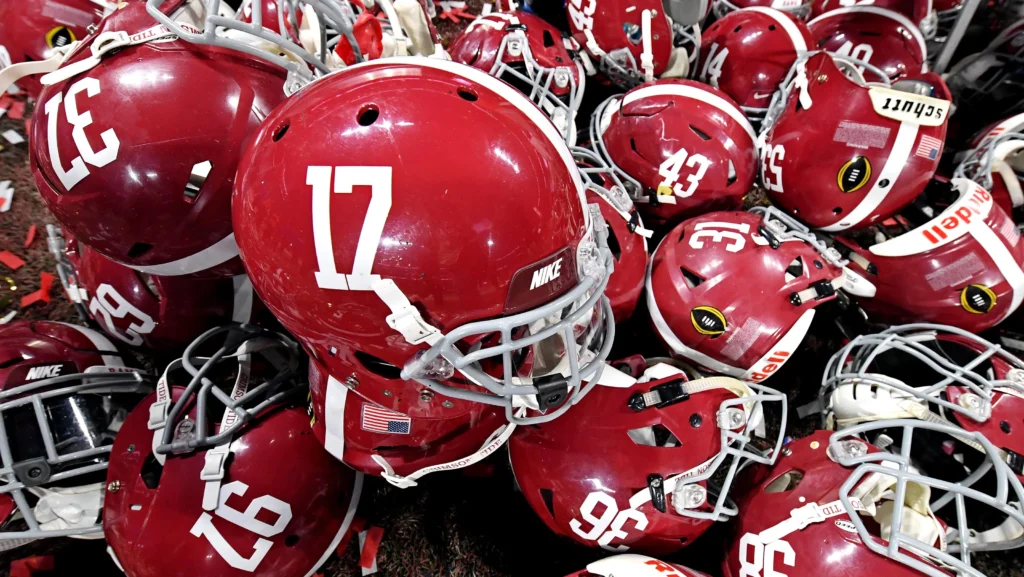
Evolution of a Symbol: The Alabama Crimson Tide Football Helmet Through the Years
The Alabama Crimson Tide football helmet is one of the most iconic visuals in college football, a symbol as recognizable as the team’s dominant legacy. Over the decades, while the program has evolved into one of the most storied in the sport’s history, the helmet has remained a steady, traditional presence—emblematic of discipline, history, and pride. Though seemingly simple in design, the Crimson Tide helmet has undergone subtle transformations that reflect not only the passage of time but also the evolution of college football and the identity of the University of Alabama itself.
In the early days of Alabama football, helmets were not the essential, polished tools of modern protection they are today. In fact, the earliest Crimson Tide squads in the late 1800s and early 1900s played without helmets at all. The concept of player safety was in its infancy, and protective gear was minimal. But as the sport grew more physical and gained popularity, leather helmets began to appear. These early headgear models, worn in the 1920s and 1930s, offered little in the way of actual protection. They were thin, lacked facemasks, and were often handmade or rudimentarily constructed, though they served the purpose of providing some padding against the brutal collisions of the game.
In those early decades, Alabama’s leather helmets weren’t marked by the now-familiar crimson hue. Like many teams of the time, they used brown or black leather helmets—unadorned and purely functional. It wasn’t until the late 1930s and early 1940s that the idea of painting helmets became a widespread trend in college football, with teams looking for ways to stand out and create a recognizable brand. For Alabama, the transition to colored helmets coincided with the team’s rise as a national powerhouse under coaches like Frank Thomas.
By the 1950s, as leather gave way to the more modern plastic helmets, Alabama began introducing crimson as the primary color of the helmet. It was a powerful move—crimson had long been associated with the program and was already central to the team’s nickname. The new helmets helped cement the team’s visual identity. The facemask was another development of this era. Originally a single-bar or two-bar design made from metal, it was eventually coated with rubber or plastic to improve player safety.
The next major evolution came in 1957, when head coach Paul “Bear” Bryant took over the program. One of the most transformative figures in college football history, Bryant’s influence extended well beyond strategy and leadership; he also helped formalize the visual brand of Alabama football. The crimson helmet was retained, but now it bore the player’s number in white on both sides—a clean, simple, and effective design. This minimalist style was consistent with Bryant’s no-nonsense philosophy. For him, Alabama football wasn’t about flash or gimmickry—it was about toughness, tradition, and execution.
The numbered helmets soon became synonymous with Alabama. While other teams were adopting flashy logos or striping patterns, the Tide kept things traditional. This, ironically, made the helmets stand out even more. In a sea of modernization, Alabama’s throwback simplicity was a statement in itself. The numbers were block-style, large enough to be easily visible from the stands, and served a dual purpose: helping fans identify players and reinforcing the team-first mentality.
During the 1960s and 1970s, as Bear Bryant’s teams dominated college football, winning national championships and producing All-Americans, the helmet became a symbol of excellence. The image of players in crimson helmets with white numerals, charging onto the field at Legion Field or Bryant–Denny Stadium, became etched into the national consciousness. The design never changed, even as the sport’s visual aesthetics evolved around it.
In the 1980s and 1990s, as helmet technology improved, Alabama updated the materials and structure of the helmet while maintaining the same look. Brands like Riddell and Schutt became standard manufacturers for college programs, offering better padding, more effective facemasks, and improved comfort. But the Tide held firm on aesthetics. In an era when many programs flirted with chrome finishes, animal print textures, and bold alternates, Alabama remained staunchly traditional. The only major deviation came during the 1984 season when the team briefly wore a white helmet for two games. The experiment, under head coach Ray Perkins, featured crimson player numbers on the sides but was quickly abandoned and never returned. Most fans and alumni viewed it as a break from tradition, and the return to the all-crimson design was widely welcomed.
As the 2000s arrived and Nick Saban took the reins in 2007, Alabama football entered another golden era. With it, the helmet once again took on symbolic weight. Saban, like Bryant before him, embodied a no-frills, all-business philosophy that perfectly aligned with the helmet’s traditional look. Under Saban, the crimson helmet with white numbers wasn’t just gear—it was a crown of legacy, a battle-tested emblem worn by national champions, Heisman winners, and first-round NFL Draft picks.
Though the external design remained unchanged, Saban’s tenure saw the incorporation of modern helmet technology to enhance player safety. This included adopting newer helmet models from brands like Riddell (such as the SpeedFlex) and Xenith, with improved concussion protection and customizable padding systems. These helmets were still painted the traditional crimson, still bore the white numbers, but represented the cutting-edge of football equipment beneath the surface.
Another quiet evolution came with the addition of subtle details. Some helmets featured small decals commemorating achievements or honoring past players and coaches. For instance, during special games, Alabama players might wear a commemorative sticker for a teammate or to honor a milestone. But these additions were rare and never overshadowed the helmet’s clean, classic appearance.
In recent years, with the rise of social media and alternate uniforms dominating recruiting pitches, Alabama’s helmet has almost become a cultural statement. Recruits are drawn to the program not because of trendy uniforms but because the helmet represents tradition, excellence, and a pathway to the NFL. The very refusal to change has become a branding tool. The helmet says: We are Alabama. We don’t need to reinvent ourselves. We are the standard.
The Crimson Tide helmet has also been a fixture in countless iconic moments—whether it was Mark Ingram racing down the sideline en route to a Heisman Trophy, Tua Tagovailoa throwing a walk-off touchdown in the national championship game, or Bryce Young directing a game-winning drive. The helmet is present in the highlights, in the statues outside the stadium, and in the hearts of fans across generations.
Collectors and fans today covet replicas of different eras of Alabama helmets. From leather throwbacks to 1950s Riddell designs to the modern SpeedFlex shells worn in CFP championships, each version tells a story of a time, a team, and a tradition. The crimson color has deepened slightly over the years, the numbers have become sleeker with modern materials, but the essence has never changed.
In an age of visual overkill and constant reinvention, the Alabama Crimson Tide football helmet remains a beacon of consistency. It is a powerful reminder that some traditions are best left untouched—that greatness doesn’t always need to shout. Sometimes, it simply steps onto the field, clean and crimson, ready to dominate once again.





